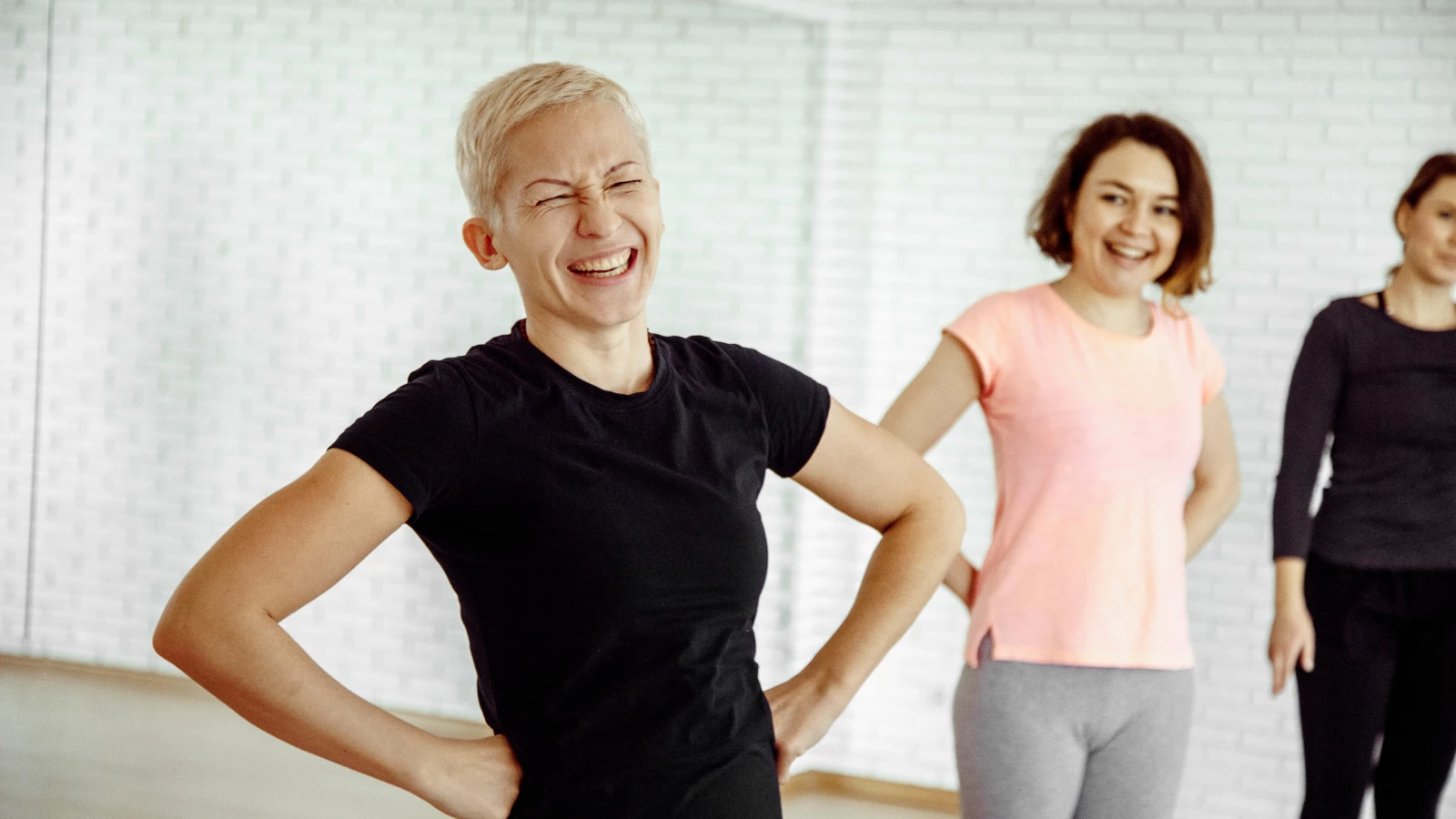Finding Joy: How to Welcome Humor into Your Yoga Practice

Have you ever laughed in a yoga class—like, really laughed—maybe at a joke from your instructor or after falling out of a tricky pose? How did it feel? How did it affect the experience of that practice? Laughter is most often an involuntary expression of present-moment joy. From long before Goat Yoga and Lululemon, yoga’s true purpose has been to find present-moment joy, that ultimate, sometimes seemingly elusive state of samadhi (pure bliss). To find humor within difficulty is also a form of santosha (contentment) and aparigraha (non-greed and detachment). Let’s look more closely at how this part of the human experience can enhance our yoga practice.
Yoga and Self-deprecation, Non-Judgment, and Acceptance

Self-deprecation is a tool of many successful comedians. When it’s genuinely humanizing and demonstrates humility, it can really resonate. It can communicate, “Here’s how I’m not perfect. You don’t have to try to be perfect either.”
When self-deprecation goes into a place of self-judgment and anger at oneself, it’s less effective and is not empowering for oneself and others. Each situation is unique. Introspection and inner wisdom can show us the difference.
How to Inject Laughter into Yoga Classes

How does this fit into yoga? For teachers, laughing a bit at your limitations can begin breaking down the teacher-student hierarchy within yoga classes. It can foster an environment wherein it’s understood that the teacher is there to guide their students, but has much to learn from them as well. Teachers are just as human and imperfect as their students and have only taken a life path leading them to the front of the class rather than in the back of it, although teachers so often take class themselves as well.
If you fall out of a pose that you’re demonstrating or blank out in the middle of teaching a sequence, try smiling and making a little joke, then backtracking to try again. See how that feels, rather than judging yourself or being embarrassed at your misstep. It can also be easy to compare yourself to other teachers. In the context of satya (truthfulness), that can be comparing apples and oranges, because their path has not been yours, and vice-versa.
Much of this applies to practicing as a student. If you fall out of a pose or need to rest, can you smile a bit to yourself and breathe a little deeper? Can you laugh at yourself, in the spirit of not taking yourself—and the practice—so seriously?
Yoga is an ancient and endlessly wise practice, and we should always honor its wisdom and power. Yet the stakes aren’t so high that “failure” is something to respond to with negative emotions. (What “failure” really means in yoga is perhaps a layered discussion for another day!)
If we experience negative emotions at something like falling out of a pose or needing to take a rest, that’s part of the journey, and judging ourselves for that isn’t productive. We have it within us to keep stepping forward on our journey of practice, and in so doing, move closer to pure bliss.
Lastly, if a teacher makes a joke, can we laugh along? Can we let go of self-imposed seriousness and stoicism, and just let ourselves experience that momentary joy? If you’re practicing alone at home, no one can hear, so why not let out a big belly laugh?
For both teachers and students, finding humor in our practice can be a “letting go” of seeking perfection, while also joyfully reaching for a new goal and accomplishment. There is both contentment and empowerment in that balance, and that’s a potent blend. Yoga teaches us that though our inner power is boundless, we are human and fallible. Humor and laughter is a way to claim that inner power in the face of human fallibility and to find acceptance of that fallibility.
How to Create Connection Through Laughter

That momentary joy of laughter is humanizing and breaks barriers. Humor and laughter are something that we can share in one present moment, no matter who we are and what our life experience has been. In group classes, sharing a humorous moment can build greater connection in the room, a connection of individuals traveling their own path toward empowerment, healing, and bliss—together.
In some classes, the pressure we put on ourselves individually in practice to be “perfect” can build tangible tension in the air. Big smiles and the sound of laughter can palpably dissolve that tension. If you’ve ever experienced kids’ yoga—viewing, teaching, or practicing with young ones—this is the connected, open, and energetic atmosphere that predominates. Children can teach us laughter’s power to humanize and connect, and help us to let go.
On an even more practical level, Laughter Yoga shows us how the voluntary act of laughing can make us feel more joyful. In a sense, this is the “fake it ‘til you make it” ethos. Intending to laugh and laughing involuntarily have the same effect on the body, mind, and spirit, so why not just laugh on purpose? Combining that approach with finding moments of spontaneous, unintended joy through laughter can make the presence of humor in our practice (and our lives) all the more powerful and meaningful. Joy is contagious and infectious, and it can start with you today!
Also, read...
Warrior I Pose: 5 Strengthening Variations
Deepening Your Home Yoga Practice: An Interview with Judith Hanson Lasater
4 Easy Ways to Use a Sandbag in Yoga Practice
Related courses
Breath as Medicine: Yogic Breathing for Vital Aging
Yoga and Myofascial Release: Releasing Chronic Tension with the Bodymind Ballwork Method
Yoga and Detoxification: Tips for Stimulating Lymphatic Health

Kathryn Boland is an RCYT and R-DMT (Registered Dance/Movement Therapist). She is originally from Rhode Island, attended The George Washington University (Washington, DC) for an undergraduate degree in Dance (where she first encountered yoga), and Lesley University for an MA in Clinical Mental Health Counseling, Expressive Therapies: Dance/Movement Therapy. She has taught yoga to diverse populations in varied locations. As a dancer, she has always loved to keep moving and flowing in practicing more active Vinyasa-style forms. Her interests have recently evolved to include Yin and therapeutic yoga, and aligning those forms with Laban Movement Analysis to serve the needs of various groups (such as Alzheimer’s Disease patients, children diagnosed with ADHD, PTSD-afflicted veterans – all of which are demographically expanding). She believes in finding the opportunity within every adversity, and doing all that she can to help others live with a bit more breath and flow!



